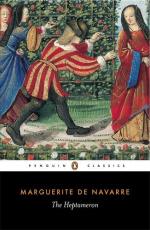1 The Basques give the name of Gave to those watercourses which become torrents in certain seasons. The Bearnese Gave, so named because it passes through the territory of the ancient city of Beam, takes its source in the Pyrenees, and flows past Pau to Sorde, where it joins the Adour, which falls into the sea at Bayonne. It is nowadays generally known as the Gave of Pau.—L. & M.
Then certain of the company thought to stem the force of the current by crossing in a body, but they were quickly carried away, and the others who had been about to follow lost all inclination to do so. Accordingly they separated, as much because they were not all of one mind as to find some other way. Some crossed over the mountains, and passing through Aragon came to the county of Rousillon, and thence to Narbonne; whilst others made straight for Barcelona, going thence by sea, some to Marseilles and others to Aigues-Mortes.
But a widow lady of long experience, named Oisille, resolved to lay aside all fear of bad roads and to betake herself to Our Lady of Serrance.(3)
3 The Abbey of Our Lady of Serrance, or more correctly Sarrances, in the valley of Aspe, was occupied by monks of the Premontre Order, who were under the patronage of St. Mary. An apparition of the Virgin having been reported in the vicinity, pilgrimages were made to Sarrances on the feasts of her nativity (Sept. 8) and her assumption (Aug. 15). In 1385 Gaston de Foix, who greatly enriched the abbey, built a residence in the neighbourhood, his example being followed by the Gramonts, the Miollens, and other nobles. The pilgrimages had become very celebrated in the fifteenth century, when Louis XI. repaired to Sarrances, accompanied by Coictier, his physician. In 1569, however, the Huguenots pillaged and burned down the abbey, together with the royal and other residences. The monks who escaped the flames were put to the sword.—M. & Ed.
She was not, indeed, so superstitious as to think that the glorious Virgin would leave her seat at her Son’s right hand to come and dwell in a desolate country, but she was desirous to see the hallowed spot of which she had so often heard, and further she was sure that if there were a means of escaping from a danger, the monks would certainly find it out. At last she arrived, after passing through places so strange, and so difficult in the going up and coming down, that, in spite of her years and weight, she had perforce gone most of the way on foot But the most piteous thing was, that the greater part of her servants and horses were left dead on the way, and she had but one man and one woman with her on arriving at Serrance, where she was charitably received by the monks.




